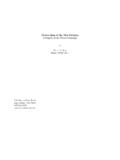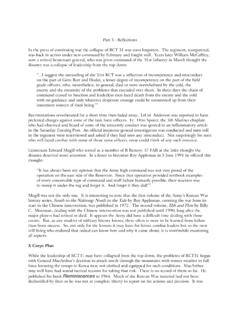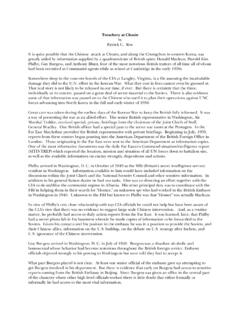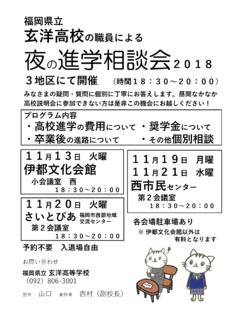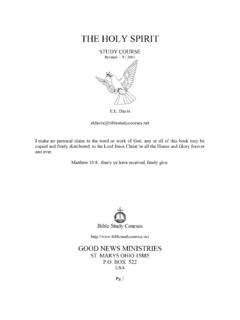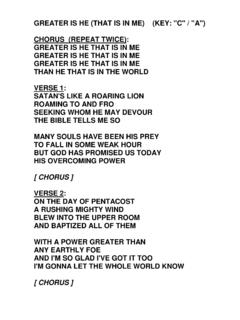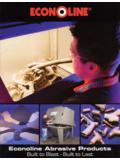Transcription of The Ghost Armies of Manchuria - Chosin Reservoir
1 Ghost Armies - 1 The Ghost Armies of ManchuriaBy Patrick C. Roe(Based on the book The Dragon Strikes by Patrick C. Roe)By the middle of October UN Command forces were rushing northward in what they hoped was a final push to end theKorean War. North Korean forces were withdrawing in disarray, their resistance crumbling much faster than expected. On the East Coast ROK troops pushed rapidly north securing Wonsan on the 11th and Hamhung on the 17th. In thewest the 1st Cavalry Division and the 1st ROK division reached Pyongyang in a dead heat on the 19th. By the 24th forceson both sides of the peninsula had reached the original stop line for non-ROK forces approved by the Joint Chiefs ofStaff, the line Chongchon River across to Hamhung . Troops of the X Corps were afloat off Wonsan; their landingblocked by mines; their cross peninsula dash to secure Pyongyang no longer needed.
2 Over this euphoria of apparent success loomed the threat of Chinese intervention. In Tokyo General Willoughby,MacArthur s G-2, continued to total up the increasing Chinese strength in Manchuria and repeatedly note their potentialfor intervention. But the conventional wisdom was stated in a CIA memorandum of 12 October prepared for PresidentTruman: The Chinese Communist ground forces, currently lacking requisite air and naval support, are capable ofintervening effectively but not necessarily decisively, in the Korean full-scale Chinese Communistintervention in Korea must be regarded as a continuing possibility, a consideration of all known factors leads to theconclusion that barring a Soviet decision for global war, such action is not probable in 1950. During this period,intervention will probably be confined to continued covert assistance to the North Koreans.
3 1 One of the reasons given was: From a military standpoint the most favorable time for intervention in Korea haspassed. MacArthur, on 17 October, apparently concerned that substantial North Korean elements might escape, withoutconsulting the Joint Chiefs of Staff, issued instructions for an advance to a new stop line farther north into themountains. The advance was to commence on his Two days later he ordered all forces to make a maximumeffort to reach the new line prepared for a continued advance to the border of North Korea. On the 24th he lifted allrestrictions on the use of UN troops and ordered his commanders to Adrive forward with all speed and with the fullutilization of all their forces to the Manchurian following day UNC forces in the east and the west collided with Chinese Communist Forces.
4 Unknown toMacArthur and his commanders and against all expectations twelve divisions of the Chinese Communist Army hadcommenced crossing into Korea with the objective of establishing a defensive line very close to that which had beenchosen as the original stop line for UNC forces. The Eighth Army was brought to a halt. Just over a month later the Chinese launched a major offensive which drove the Eighth Army back to Pyongyang andsurrounded the 1st Marine Division at Chosin . But, by December 2nd the Chinese commander, General Peng Dehauirealized the Chinese attack at Chosin had faltered and, in the west the troops badly needed a respite. At 0500 thatmorning he ordered the Armies in the west to halt their pursuit, to mop up the battlefield and rest for four or five days "in order to reorganize the troops, supply food and ammunition and prepare to fight on.
5 "2 Unaware of the exhausted condition of the Chinese, but fully aware of the condition of his own troops, General Walker,on 1 December, made one of the most crucial decisions of the war. He assembled his staff and told them:"I have not been able to get MacArthur's headquarters to advise me of their intentions. In the absence ofinstructions, I shall assume that the tactical integrity of this army, on which the entire defense of Japan depends, ismy paramount objective. I will give up any amount of real estate if necessary to prevent this army from beingendangered. 3 The following day Generals Doyle Hickey and Edwin Wright, the chief of staff and G-3 of the Far Eastern Command,representing General MacArthur, arrived in Walker s headquarters, reviewed the situation and approved Walker sGhost Armies - 2decision.
6 The Far Eastern command intelligence summary for that day concluded that the Chinese were capable ofseizing Kaesong, preventing the Eighth Army from reaching Seoul and destroying US field forces in Korea. A majorfactor in this estimate was the Chinese capability to reinforce with huge forces in Manchuria , forces which in actuality didnot exist - the Ghost Armies of forces withdrew back below the Han River. The course and the outcome of the war was totally changed. Insteadof reunifying Korea after shedding much additional blood we eventually settled for an armistice generally along the 38thParallel. The Chinese Communists of the People s Republic of China were suddenly transformed from a rogue regime ofdoubtful legitimacy to a major player in the Far East. Few intelligence failures in recent history have had such drasticresults.
7 The effects are still with us today. The Chinese ProblemWhen the war commenced the Chinese were as unprepared as were US forces, if not more so. The PLA was primitivelyarmed and equipped. It has been described as a 1914 army without the artillery. It was tired from twenty years of the PLA heated debate raged over their ability to fight a modern military force. The great Chinese advantage wasa huge Reservoir of manpower. But the PLA was poorly disposed. The UNC forces might reach the Yalu before the fullforce of the PLA could be brought to bear. The Chinese, as dedicated students of Sun Tzu, had one other great asset - guile. If the UN Command could be madeto believe the Chinese had deployed only token forces, UNC forces could be led to advance into the mountainouswhere the terrain would offset some of the Chinese disadvantage.
8 UNC forces could then be held there until additionalChinese reinforcement could arrive. Then a major counteroffensive might achieve great surprise and shock, solution was a coordinated campaign of deception. The objective was to make the initial CCF forces in Koreaappear much smaller than they were; then, when the main offensive was launched, to make the available forces lookmuch larger than they were. There is no single source which says this was planned and coordinated but the six elementsof the deception plan did not all occur simultaneously by key to the plan was to capitalize on American technological advantage and provide misleading order of battleinformation. A networkd of radio operators transmitting imaginary traffic were used to simulate additional unitsassembling in Manchuria .
9 General Nie Rongzhen, the PLA s acting chief of staff during the Korean War, had practiceda variation of that technique in the Wutai Mountains of North China while withdrawing before a Japanese offensive inthe spring of 1941. As will be seen, much of the CCF order of battle in Manchuria obtained by Willoughby had to havecome from traffic analysis by ASA units. Had that information come from an agent network, or a highly placed agent,such a source would surely have been able to warn of large forces crossing into Korea. Deceptive plain text traffic, suchas the announcement of Lin Piao as the potential Chinese commander in Korea supplemented the effort. To make that deception work all movement into Korea had to be conducted with total secrecy. By moving only at night,maintaining a draconian march discipline, and using back roads and trails the Chinese were able to deploy some 220,000men in Western Korea, initially, and 150,000 more later in Northeast Korea, without revealing their strength.
10 Until theactual offensive began they totally escaped observation by aircraft. It was a superlative achievement. Prisoners briefed to give misleading unit designations were an essential part of the deception effort. To provide a screenfor their entry into Korea each of the 38th, 39th and 40th Armies , the first three entering in western Korea, formed acovering force by taking one battalion from each of the divisions in their army. The task forces were designated as the54th, 55th and 56th Unit. A prisoner from the 114th Division s contribution to the task force would identify himself asbelonging to the 1st Battalion of the 54th Unit. Some of the prisoners apparently continued to identify themselves in thatway even after they had rejoined their parent unit. This led to intelligence officer in the Eighth Army, and at FEC, toinitially believe that they were faced only by task force units of regimental further confusion was the Chinese withdrawal starting on 6 November.
